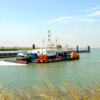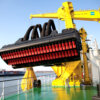“Facts About Water Injection Dredging” describes a relatively new hydrodynamic dredging technique that is low-impact, economically viable and environmentally sound.
Water injection dredging (WID) has very specific limitations but in the appropriate situation it also has very specific benefits. The mobilisation and capital costs of dredging plant are quite significant. Since port authorities are continually confronted with the siltation of the harbours and access waterways channels, regular maintenance dredging is a necessity to ensure safe navigation depths in these.
Generally speaking the larger the port project, the more cost-efficient dredging becomes using traditional dredging techniques – trailing suction hopper dredgers and cutters. But not every operation requires major dredging equipment and for smaller ports the financial demands of dredging can become burdensome. For the regular maintenance of smaller harbours, the technology of water injection dredging can be effective.
The choice of a water injection dredging vessel is site-specific and will depend on various factors such as soil conditions, hydrodynamic conditions, transport distances and maximum operating depths. The dredging depth of water injection dredging vessels varies between 26 metres to almost 0 metres. The working speed is 1 to 2 knots although most of them are able to sail faster in non-dredge mode. Portable water injection dredging vessels can be rapidly deployed to relatively remote sites when necessary.
In addition, water Injection dredging can provide clear advantages compared to other dredging techniques because:
- they are smaller in size, easier to mobilise and manoeuvre;
- auxiliary equipment is generally not required;
- fewer crew members are required;
- soil is not removed from the bed, but remains in its natural environment;
- the density current remains horizontal just above the waterbed and the overlying water layers are not affected;
- its CO2 -footprint per m3 of dredged sediment is considerably lower compared to conventional dredging techniques.
In appropriate circumstances, water injection dredging may provide either a stand-alone dredging solution or a complement to traditional dredging methods.
“Facts About Water Injection Dredging” answers essential questions such as:
- Why consider water injection dredging?
- What is water injection dredging?
- What is the theory behind water injection dredging?
- What are the features of a water injection dredger (wid)?
- How does water injection dredging work?
- How are important are soil conditions at the site?
- What is the influence of site-specific bathymetry and geometry?
- Why is water injection dredging especially suited to maintenance dredging?
- What are the environmental impacts of water injection dredging?
- Should water injection dredging be monitored?
- Can water injection dredging be combined with other forms of plant?
- What are the advantages of water injection dredging compared with other dredging methods?
- What are other applications for water injection dredging?
- What are the limitations for using water injection dredging?
- When to choose for water injection dredging?





